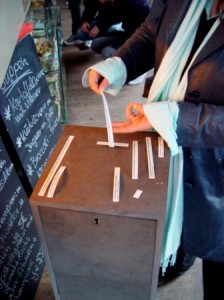default to public

Jens Wunderling (DE)
http://www.defaulttopublic.net / http://www.sport4minus.de
Award of Distinction Interactive Art
Documentation
“default to public” is a project dealing with the discrepancy between people’s feeling of privacy on the web and the physical world. It consists of an ongoing series of objects and interventions linking the physical world to the online world in unexpected and narrative ways to create awareness for self-exposure.
The three core elements of “default to public” (Status panel, Tweetleak, and Tweetscreen) cause irritating moments that neither condemn nor approve of the self-exposure; they are as neutral as Twitter itself is, yet they make strong statements regarding the perception of private and public on the web and are intended to create reflection and communication on that topic. In times of rapid change concerning communication behavior, media access and competence, the project “default to public” aims to raise awareness of the possible effects on our lives and our privacy.
All three objects follow a simple yet powerful principle: information from the Twitter network (standing for information on the web) is displayed in another public environment, the documentation of this process is fed back into the digital public sphere and the authors of the information are notified that it has been “leaked”. Two public spheres are temporarily linked, creating repercussions of communication in the digital public sphere, which seems to be regarded as less public than the physical world, although it has a far wider reach than classical media, plus it never expires or is written over.
Status panel, a classic awareness-design piece, enhances the functionality of a well-known interface. Tweetleak, a monolithic anthracite-colored pole, which is placed in a public place, collects tweets from nearby and “materializes” them. The collected fragments from people’s lives on the web leave the digital public space on adhesive paper strips.
Tweetscreen is a networked projection/installation in public space, displaying “tweets” that have been written near its own physical location on a large projection screen, transferring them to a medium, widely received as “public”.
